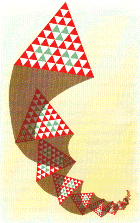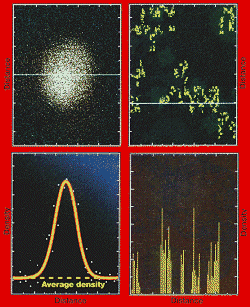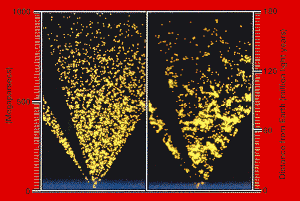 |
Fractured Universe
|
 |
| Self similar fractals look the same at every scale |
A dissident group of astronomers is claiming that the Universe is not the smooth, homogeneous place that Einstein envisaged. If they're right, says Marcus Chown, the foundations of cosmology could crumble to dust
WHEN cosmologists speculate on the nature of the Universe,
they make an unspoken assumption-that matter is spread uniformly throughout
space. Yet when astronomers peer out across the Universe they see something
very different. Galaxies are gathered together in great chains and walls
which snake around vast regions of empty space called voids. The Universe
appears anything but uniform.
"Yes, there does appear to be a contradiction," admits Ofer Lahav of the
Hebrew University in Jerusalem and the Institute of Astronomy in Cambridge.
But Lahav contends that the Universe, though undeniably clumpy on the small
scale, becomes smooth on the largest scales. "I like to think of it as an
ocean, which looks choppy on the scale of individual waves but from far above,
on scale of tens of kilometres, is perfectly smooth," he says.
Lahav's is very much the conventional view. "I would say that
more than 95 per cent of astronomers believe the Universe is uniform on the
very large scale," says Peter Coles, professor of astrophysics at the University
of Nottingham. But an opposing opinion is now causing a stir. A maverick
group based in Europe has suggested that the Universe never becomes smoothed
out, even on the largest scales. "My contention is that it is clumpy on all
the scales so far explored," says Francesco Sylos Labini, an astronomer at
the University of Geneva. "In fact, studies we have done show that the
distribution of matter is fractal, just like a tree
or a cloud." If this dissenting view is correct and the Universe doesn't
become smoothed out on the very largest scales, the consequences for cosmology
are profound. "We're lost," says Coles. "The foundations of the big bang
models would crumble away. We'd be left with no explanation for the big bang,
or galaxy formation, or the distribution of galaxies in the Universe."
The standard models for describing the
big bang and the evolution of the Universe are
called Friedmann-RobertsonWalker (FRW) models. Their starting point was general
relativity, the theory of gravity published by
Einstein in 1915. In 1922, following Einstein's
lead, the Russian physicist Aleksandr Friedmann applied general relativity
to the whole Universe. (His equations were later recast by the American
cosmologist Howard Robertson and Briton Arthur Walker). It was Einstein and
Friedmann who first made the assumption that the Universe is both homogeneous-the
same in all places-and isotropic-the same in all directions. This is known
as the Cosmological Principle.
There were two reasons for making such an assumption. The first was purely
practical: Einstein's complex equations are extremely difficult to solve
for a Universe that is not smooth. The second reflected a scarcity of
observations of the Universe. "Nobody knew anything about the largescale
structure of the Universe-galaxies weren't even generally accepted as the
building blocks of the cosmos,says Lahav "The simplest thing in the circumstances
was to apply Ockham's razor and assume a homogeneous and isotropic
Universe."
For most of this century this assumption has been impossible to prove
observationally. But now astronomers have begun to observe a big enough chunk
of the Universe to at last put it to the test. In the 1980s, two of the most
important galaxy surveys were the CfA red shift survey, carried out by Margaret
Geller and John Huchra of Harvard-Smithsonian Center for Astrophysics, and
the IRAS red shift survey carried out using NASA's Infrared Astronomical
Satellite. Both probed out to about 300 million light years-or, to put it
another way, they looked back to a time when the Universe was about 95 per
cent of its present age.
There is no doubt that on this relatively small scale, the Universe is far
from homogeneous. Most astronomers talk of "hierarchical clustering"-galaxies
clumping together into clusters and clusters into superclusters. One commonly
used measure of homogeneity is the "two-point correlation function". This
is the probability of observing a galaxy at a certain distance from a chosen
galaxy compared with the probability of finding one at the same distance
if galaxies are spread uniformly throughout space. It turns out that you
are twice as likely to find a galaxy at 15 million light years from a given
galaxy in the real Universe as in a uniform Universe. However, according
to Lahav and his Cambridge colleagues Kelvin Wu and Martin Rees, this measure
gradually declines towards 1 as scale increases. They estimate that the Universe
becomes nearly homogeneous on scales larger than about 900 million light
years-looking back to when the Universe was about 85 per cent of its present
age. "On the largest scales we have probed, the Universe appears to become
perfectly smooth," says Lahav.
 |
Conflicting ideas: conventionally, a galaxy cluster (top left) can be seen as a density fluctuation in a Universe with an average density of galaxies. The density profile of this cluster -measured along the pale blue line-is shown bottom left. Sylos Labini and colleagues argue that this approach is doomed because in a fractal Universe (top right), average density is meaningless. Here, density changes at every point (bottom right) |
Fractal dimension
But the mavericks, led by Lucian Pietronero of the University of Rome,
dispute this. Having analysed the same galaxy surveys as everyone else, they
claim that hierarchical clustering continues through to the very largest
scales. This property, of similar patterns recurring at every scale, is a
defining characteristic of fractals. "Our tests
show that the Universe never becomes homogeneous in the available galaxy
samples," says Sylos Labini, who began his work while in Pietronero's team.
"It remains hierarchically clustered. It remains
fractal."
The team maintains that orthodox cosmologists are mistaken. "What they are
seeing is an artefact of the way they analyse galaxy surveys," says Sylos
Labini. In conventional calculations of how close to homogeneity the Universe
is-the two-point correlation function, for example -astronomers look for
departures from the average density of the Universe. This necessarily assumes
that there is such a thing as average density (see Diagrams, above left).
"If the Universe is fractal, however, it has no characteristic scale," says
Sylos Labini. "Everything, including the average density, changes with scale
so the concept is meaningless. It's not surprising that people find the Universe
is homogeneous when homogeneity is one of their basic assumptions."
To avoid this, Pietronero and his team calculate the extent of galaxy clustering
by using statistical methods that take account of the properties of
fractals. The simplest technique is to measure the number of neighbours around
a chosen galaxy within a radius R. In fractal maths, this number is
proportional to RD, where D, the fractal
dimension, can have any value between 0 and 3. When D is 3, galaxies
are distributed evenly within a sphere - the conventional view. But when
D is not a whole number-fractal, that is-the galaxies cease to be
distributed evenly.
From their measurements, Pietronero and his colleagues estimate that D
is about 2.1, implying that the Universe is fractal on scales up to 300 million
light years. There is a proviso, however. "We should not forget the invisible
'dark' matter, which is thought to account for at least 90 per cent of the
mass in the Universe," says Sylos Labini.
If the voids we see, apparently empty of galaxies, are in fact full of dark
matter, then the Universe may still be homogeneous and FRW models will apply.
"However, it seems very unlikely that the clustering of ordinary light-emitting
matter and dark matter would be completely different," says Sylos Labini.
If, on the other hand, the voids are empty of dark matter and the distribution
of dark matter is roughly the same as that of ordinary matter, then the Universe
is even more inhomogeneous than the luminous matter indicates.
Of crucial importance, then, are observations that are sensitive to the
distribution of all matter rather than merely the distribution of luminous
matter, which is what the galaxy surveys provide. One such probe is provided
by the "streaming motions" of galaxies. As well as taking part in the continuing
expansion of the Universe, some galaxies are also attracted by the gravity
of unseen concentrations of mass, and move towards them. From this streaming
motion, astronomers can deduce the total amount of matter pulling them through
space.
 |
| Red shift: galaxies revealed by the European Slice Project in a 20 by 1 degree slice of sky are grouped into clusters and strings (right). If they were distributed smoothly, they would look like the simulation on the left. (The diagrams assume a Hubble constant of 55 kilometres per second per megaparsec) |
Invisible mass
Another mass probe is provided by galaxies whose light is distorted, or
"gravitationally lensed", by the gravity of matter close to the path it takes
on its journey to Earth. "The indications so far are that the visible mass
in the Universe roughly traces out the invisible mass," says Lahav. So dark
matter does not bolster Sylos Labini's contention that the Universe is fractal
(or, for that matter, Lahav's that the Universe is fractal on small scales
and homogeneous on larger ones.)
But just suppose the Universe were fractal. Would it be the catastrophe that
theorists claim? Would it mean abandoning the existing cosmological models?
"Yes," says Sylos Labini. "The usual FRW models all assume a Universe with
a constant matter density."
One way we could obtain solutions to Einstein's equations for a nonuniform
Universe would be to assume that the inhomogeneity is simply a small
"perturbation" on a homogeneous Universe. But this won't work for a fractal
Universe, because it is more than a mere perturbation-it is radically different.
The problem with a fractal is that it cannot even be described at each
point in space by the formulas that conventional theory uses. "It is
impossible to solve Einstein's equations exactly for a fractal distribution
of matter," says Sylos Labini.
Despite this formidable theoretical challenges, Sylos Labini believes a fractal
Universe is more exciting than a homogeneous one. "We are facing a new and
challenging problem which we are a long way from solving," he says. "For
some questions, the fractal structure leads to a radically new perspective
and this is hard to accept. But it is based on the best data and analyses
available. It is neither a conjecture nor a model-it is a fact."
Few would go anything like as far as this, though Coles admits that galaxy
surveys as yet provide only weak evidence that matter is distributed smoothly
throughout the Universe. "Existing galaxy surveys sample too small a volume
to show the scale of homogeneity," he says.
But Lahav and his colleagues do not rely solely on galaxy surveys to support
their case that the Universe is ultimately homogeneous. They bolster it with
other evidence, such as the cosmic background radiation, the microwave
"afterglow" of the big bang which still fills the Universe 15 billion years
after the event. Since this radiation comes from an era within a mere 300
000 years of the birth of the Universe, it gives a look-back time close to
0 per cent the age of the Universe.
In 1991, NASA's Cosmic Background Explorer satellite (COBE) discovered that
the temperature of the background radiation varies by less than 1 part in
100 000 from one direction in the sky to another. Since the radiation was
in intimate contact with matter at the time, this allows astronomers to estimate
the smoothness of matter at the beginning of the Universe. "We're talking
about no variations bigger than 1 part in 100 000," says Lahav. "So, on the
biggest scales possible, the Universe is almost completely smooth."
Not unexpectedly, Sylos Labini sees things differently. He questions the
wisdom of jumping straight from the distribution of radiation seen by COBE
to that of matter. "Inferring the distribution of matter from the distribution
of radiation requires a complex theory with many assumptions," he says. "We
should be very cautious."
On the other hand, Lahav points out that Sylos Labini and his colleagues
have trouble explaining why there should be a fractal distribution of matter
in the Universe. "There is no dynamical theory to explain how such a fractal
Universe could have arisen from the pretty smooth initial state we know existed
in the big bang," says Lahav.
"Yes, that's true," admits Sylos Labini. "It's a very difficult problem:
how does gravity turn an initially smooth distribution of matter to a fractal
one?" But just because something is hard to explain has nothing to do
with whether it is true or not. "Facing a hard problem is far more
interesting than hiding it under the rug by an inconsistent procedure," he
says.
By contrast, Lahav says his picture is easier to explain. "The transition
from hierarchical clustering to homogeneity is completely compatible with
the accepted ideas of galaxy formation," he says. In the conventional picture,
the Universe starts off with tiny density fluctuations-ripples in an otherwise
smooth distribution of matter. Nobody knows for sure how these came about
but a fair bet is that they were impressed on the Universe by quantum
processes in the first split second of its
existence. These are then amplified by gravity: denser regions of the
Universe have stronger gravity so they pull in more matter, making them more
dense, and so on. "It's like capitalism," says Lahav. "The rich get richer
and the poor poorer."
However, this process must also take account of the fact that the Universe
is expanding and this expansion tries to pull apart material that is trying
to clump. On the small scale gravity wins and material clumps into galaxies
and clusters-and even superciusters. But the expansion gets bigger as the
scale increases. This is the famous Hubble law, which says that the
velocity of recession of two galaxies increases in step with their separation.
Inevitably, then, there is a scale at which the expansion overwhelms gravity
and no more structures can form. "This is where we see the transition to
homogeneity," says Lahav.
There is clearly a huge gap between a look-back time of 95 per cent for the
galaxy surveys and a look-back time of close to 0 per cent for the big bang
radiation. Lahav goes as far as calling the region in between an "observational
desert". Until cosmologists find oases in this desert, the debate over whether
the Universe is homogeneous will not be resolved.
At least one such oasis does exist, and Lahav and his colleagues have recently
visited it. This is the cosmic X-ray background, a universal glow of X-rays
that was discovered in 1962 and is thought to be the total of all emissions
from "active galaxies" such as distant quasars. Lahav believes their average
distance is as much as 1800 million light years, which corresponds to a look-back
time of about 12 per cent of the age of the Universe. "The evidence from
the X-ray background is that the Universe is smooth on such large scales,"
says Lahav. Coles agrees. "I'm 99 per cent sure the Universe is homogeneous,"
he says.
Of course, Sylos Labini has a different interpretation. "I make the same
argument as for the cosmic background radiation," he says. "A fractal
distribution of active galaxies will appear isotropic on average -but
this does not imply honiogeneity."
Galaxy surveys that see farther out across the Universe are crucial for filling
the gap, and two are already under way. The American-Japanese Sloan Digital
Sky Survey, which uses a purpose-built telescope in New Mexico, should observe
a total of 1 million galaxies over a quarter of the sky. And the Anglo-Australian
Two-Degree Field, or 2dF, survey has already measured the red shift of more
than 40000 galaxies, and aims to measure 250 000. Both surveys will probe
to a look-back time of 85 per cent of the age of the Universe.
Astronomers are also trying to observe variations in the temperature of the
cosmic microwave background radiation between parts of the sky that are 1
degree apart or less. These correspond to regions of the Universe smaller
than were probed by COBE but still much larger than the biggest galaxy surveys.
So while the galaxy surveys push into the desert from one direction, the
cosmic background experiments are coming in from the other. "When they meet
in the middle, the argument will be over," says Lahav.
Further Reading
"An unprincipled Universe" by Peter Coles, Nature, vol
391, p 120(1998). |